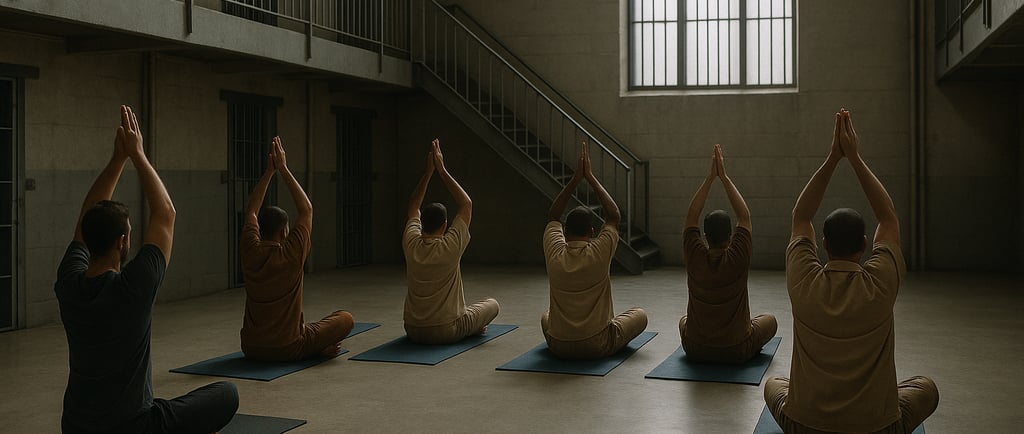Yoga Behind Bars: The Role, Rise, and Road Ahead for Yoga in Australian Prisons
In Australia’s correctional system, yoga emerged as a powerful tool for rehabilitation. We’ll examine the historical roots of prison yoga programs, their adoption in Australian states, and the growing body of evidence that supports mental, emotional, and physical benefits behind bars.
YOGA
7/13/20253 min read


Introduction
Yoga, long regarded as a practice for mental clarity, physical wellness, and emotional balance, found an unlikely yet powerful foothold within Australian prison systems over the past two decades. First trialled in a handful of correctional facilities in the early 2000s, yoga was introduced not as a luxury, but as a trauma-informed therapeutic tool, offering inmates an avenue to manage stress, reduce aggression, and build emotional resilience.
But despite promising results and international precedent, the structured rollout of yoga programs across correctional settings in Australia has faltered. In recent years, particularly following the withdrawal of NDIS funding in many facilities, yoga services have declined or disappeared altogether, leaving a significant service gap. This blog explores the journey of yoga in Australian prisons, its evidence-based benefits, international parallels, and what a structured, scalable model could look like going forward.
Origins and Early Trials in Australia
Yoga in Australian prisons began as a grassroots initiative, often driven by volunteer instructors and non-profit organisations. Early pilot programs were run in New South Wales and Victoria, with initial anecdotal feedback from corrections staff noting reduced behavioural incidents and improved emotional regulation among participants.
Over time, these small trials evolved. Programs began incorporating trauma-informed approaches, acknowledging the high prevalence of past abuse, addiction, and mental health issues in incarcerated populations. Some initiatives also included mindfulness meditation and breathing exercises, linking well with broader therapeutic and rehabilitation goals.
Benefits Documented in Research and Practice
Emerging research and internal corrections reviews began to show quantifiable benefits, echoing findings from international programs:
Reductions in aggression and violent incidents
Improved sleep and reduced anxiety or depressive symptoms
Better impulse control and reduced substance use cravings
Increased engagement in education and rehabilitation programs
Lower rates of reoffending (in international comparisons)
Yoga also provided correctional staff with a positive behavioural management tool, reducing pressure on guards and enhancing the therapeutic environment of some units.
Scope of Deployment Across Australia
Despite its benefits, yoga programs remained inconsistently deployed. They were often reliant on individual facilitators, small grants, or volunteer labour. Some high-profile programs operated through local partnerships, such as those run by not-for-profits like the Yoga Foundation and Off the Mat.
By the 2010s, some prison-based programs were supported through disability-related funding, especially under the NDIS where participants had psychosocial disabilities or complex needs. However, few were embedded as core correctional offerings, resulting in fragile continuity and limited geographic spread.
The Withdrawal of NDIS Funding
The withdrawal or ineligibility of NDIS support for yoga and other therapeutic group activities within prisons has had a significant impact.
NDIS reforms narrowed what could be funded within correctional environments. As a result, prison-based yoga, particularly when positioned as a general wellbeing or behavioural intervention, no longer met the criteria for ongoing funding. This left many programs unfunded or abruptly ended, particularly in smaller or regional correctional centres.
For inmates with psychosocial disabilities, this has meant a loss of access to one of the few self-regulating tools available in restrictive environments. It also created a service gap in addressing trauma, behavioural volatility, and mental health support in ways that were both cost-effective and non-pharmacological.
The International Context
Globally, yoga in prisons is not new. Programs in the United States, United Kingdom, India, and Scandinavian countries have all demonstrated significant benefits. The Prison Yoga Project in the US, for example, has operated for over 20 years and serves thousands of inmates each year. Studies in Sweden and Germany link yoga to improved cognitive control, reduced recidivism, and better outcomes upon release.
These international models are increasingly structured, integrating yoga into wider rehabilitative and behavioural management frameworks. They provide useful comparisons—and inspiration—for what could be adapted to the Australian context.
Opportunities for a Structured, Scalable Model in Australia
Australia has the opportunity to reimagine prison yoga, not as a fringe wellness initiative, but as a core behavioural and rehabilitative support service. To do this, a structured and scalable model would need to include:
Formal partnerships between corrective services, non-profits, and accredited yoga providers
Standardised training for instructors working in trauma-sensitive, high-risk environments
Evidence frameworks for monitoring behavioural, psychological, and health outcomes
Pathways to employment or community reintegration for inmates trained in yoga instruction
Funding diversification, including state health budgets, corrective services allocations, philanthropic support, and renewed eligibility through NDIS or equivalent health plans
A national approach could also include specialist services for women’s prisons, youth detention centres, and remand populations, each with different psychosocial profiles and needs.
Conclusion
Yoga in prisons is not a soft intervention, it is a practical, trauma-aware tool with a growing international evidence base. The Australian experience to date has shown promise, but structural barriers and funding inconsistencies have limited its full potential.
As correctional services and community agencies seek more effective, humane, and restorative approaches, yoga offers a proven, cost-effective option. The opportunity now is to move beyond ad hoc delivery and instead invest in a model that is trauma-informed, outcome-driven, and capable of operating across jurisdictions.
Groundwork Consulting believes that re-establishing yoga in Australian prisons is more than a wellness initiative, it is a smart, scalable strategy for reducing recidivism, promoting mental health, and fostering dignity in detention. We are actively seeking partnerships with yoga providers, philanthropic supporters, and justice stakeholders to develop the next phase of this work.
For more information, pilot opportunities, or to contribute to a reimagined prison yoga model in Australia, contact Groundwork Consulting at connect@ground-work.net


Far North Consulting Pty Ltd t/a Groundwork Consulting
© 2025 Groundwork Consulting
ABN 77 649 525 806
MAKING GOOD IDEAS WORK
Video Platform Links





